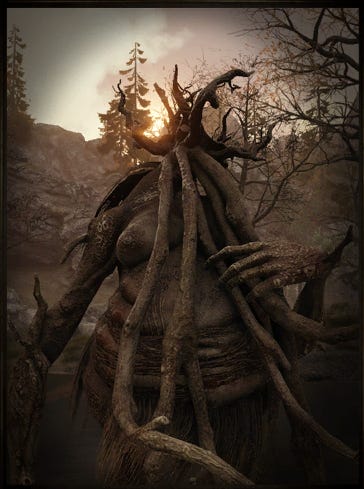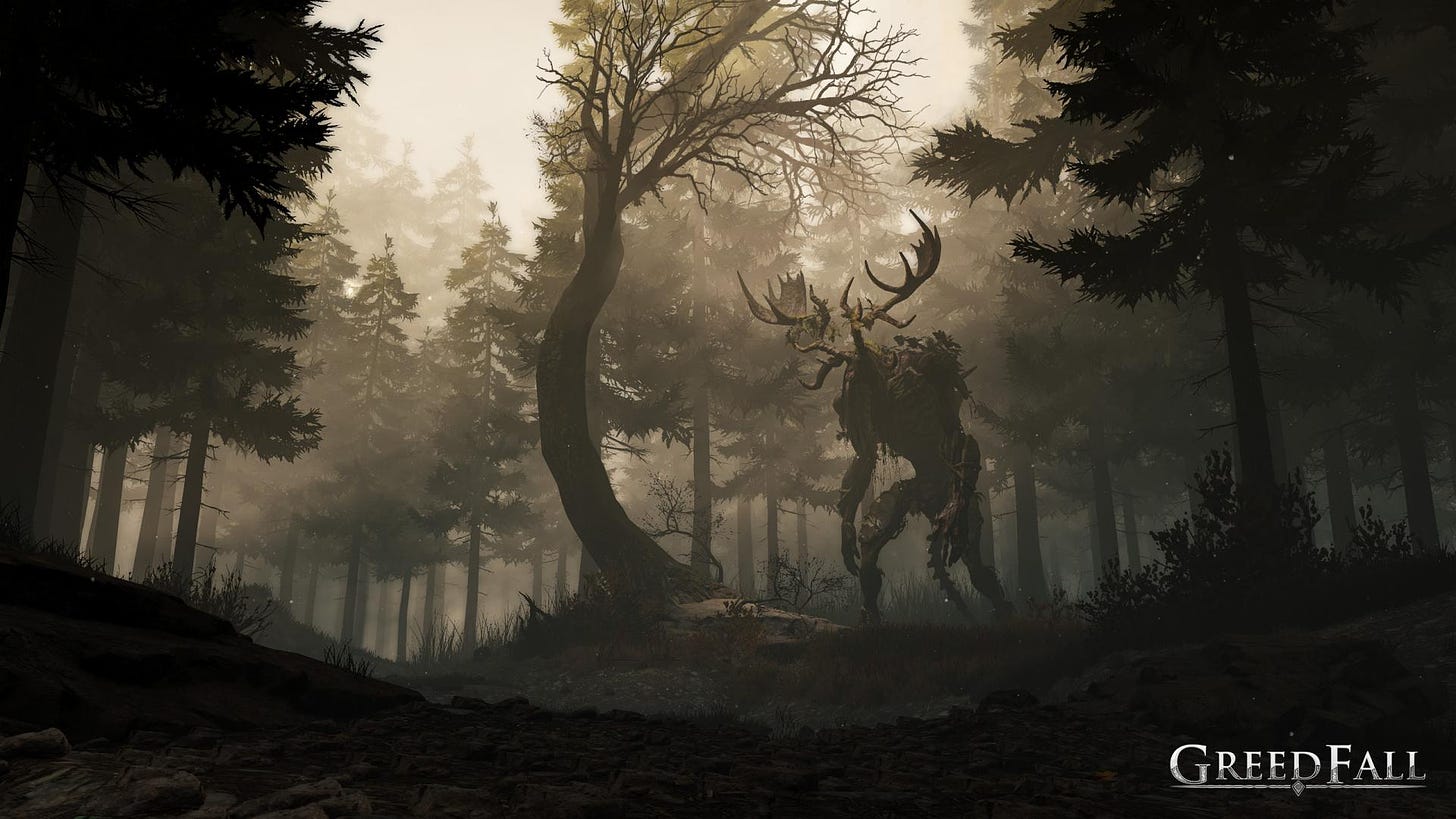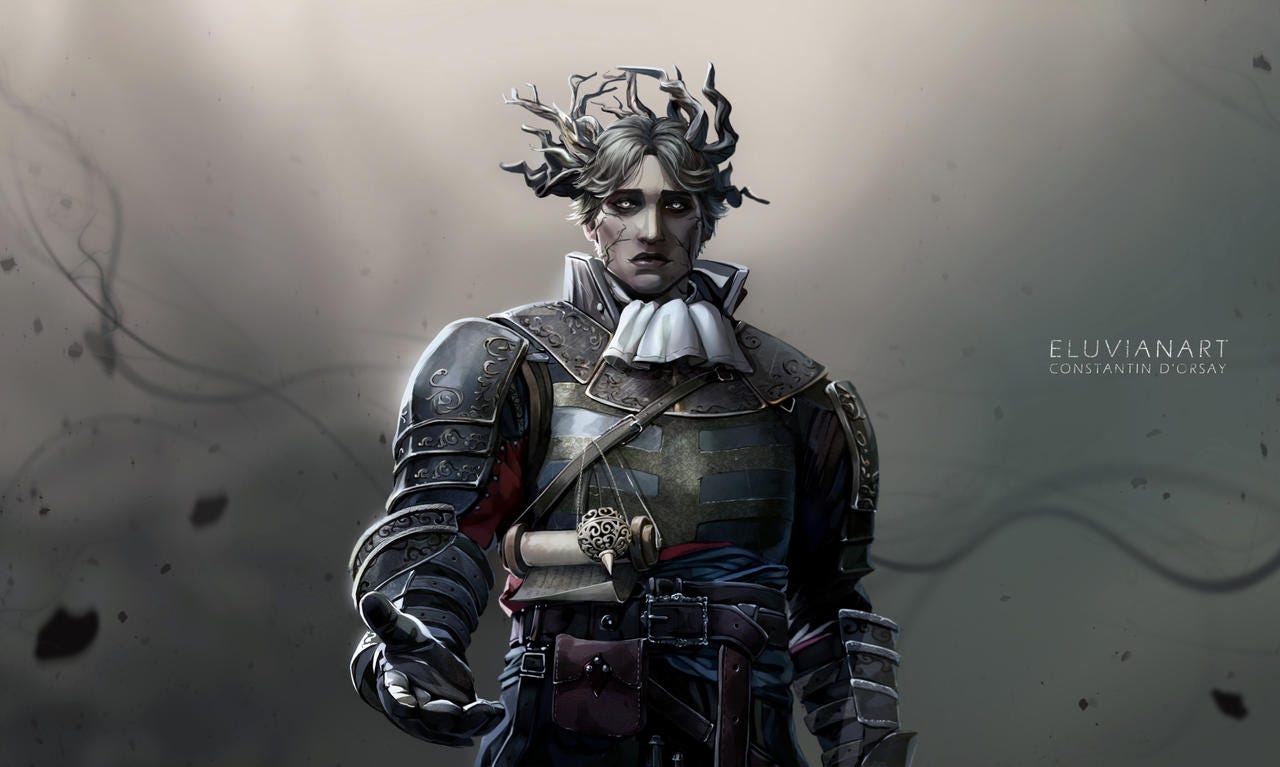The Folk Horror Elements of "GreedFall"
How Spiders implements nuance in what could have been a black-and-white decision
Although I sided with the Natives of Tír Fradí in my first playthrough of GreedFall, there were moments when I noticed how grim the culture and religion of the island could be. In spite of the horrors of war and colonization the Natives must contend with, they also commune with ancient, dark forces that strip away their humanity.
To cap off the midweek posts of “GreedFall Month” and lead us into the eerie days of October, this post is going to cover how GreedFall implements conventions of the folk horror genre in its narrative and worldbuilding.
Spoilers for the game are ahead, so if you want to experience the story of GreedFall for yourself, consider picking it up for PC or console before reading!
The subgenre of folk horror has existed in speculative fiction for over a century, gained more mainstream attention in the ‘70s with film entries like The Wicker Man (1973), drawing on some influence by then from the hippy movements of the ‘60s. A common theme of folk horror stories is to bring some ancient horror with roots in folklore or mythology local to the area it takes place in and transport it to a more modern time period. Not all folk horror stories take place in the present day, as exemplified by short stories such as “The Temple of Death” (1911) by Arthur Benson which takes place after the Christianization of Rome, or Robert Eggers’ The Witch (2015) famous for its authentic portrayal of Puritanical New England. With these stories in mind, it doesn’t always matter when a folk horror story takes place as long as it includes some clash of newer ideas and values with the ancient, horrifying secrets of the natural world.
GreedFall takes place in a secondary world during an Age of Exploration type of era, drawing inspiration from our own world’s history to inform the aesthetics, technology, and culture of the colonial factions in the game. Directly opposing them are the Natives of Tír Fradí, whose conception pulled in various inspirations from pre-industrial cultures around the world, but in my opinion quite heavily resemble Celtic-speaking peoples in language and religion.1 The Natives are mistreated, trivialized, and demonized by the colonial factions, namely the Bridge Alliance and the Magocracy of Thélème, both of whom are concerned with their esoteric traditions but for slightly differing reasons. Thélème is a highly religious society dedicated to a higher power known as the Enlightened. One of their missions is to convert the Native population into their ranks as part of gaining control over the island. Many in their faction claim peaceful intentions with their conversions despite the resistance they face from the Natives, however there are extremist inquisitors and a subfaction known as the Ordo Lumnis that use more violent or cruel measures to spread their religion. The Bridge Alliance, a faction harboring many scientists, is interested in understanding the unique connection the Natives have with Tír Fradí and the monstrous guardians of sacred sites known as nádaígeis (guardians).2 Both of these colonial factions are representative of archetypes found in folk horror stories—carriers of newer ideas and values concerning civilization, logic, and order prying into the ancient traditions of a people and landscape they do not fully understand.
The questlines where most of the folk horror tropes in GreedFall are most evident include one of the main questlines “A Cure for Malichor” and Aphra’s questline, an NPC companion. While no part of the latter questline is explicitly meant to horrify, the implications that are uncovered can lead players to some disturbing conclusions. In the quest “Demoniacal Cult” (a part of the “A Cure for the Malichor” questline), the player character De Sardet receives rumors of a possible cult (as the quest name implies) worshipping an unknown demon within the territories of more violent Native tribes. The quest leads to a cinematic where De Sardet and their party spy on a ritual conducted by members of the tribe known as the Cengeden anedas (“storm warriors”).3 The imagery in this scene, when viewed by an individual with more “civilized” sensibilities, evokes a portrait of a terrifying, primeval rite complete with a barren, twisted tree surrounded by men and women clad in attire composed of natural materials—some wearing masks in the shape of bestial faces—all while spilling their blood to the earth itself. From the beginning of the game, players are shown that the Native revere their land but it is at this point where it becomes clear to what extremes some tribes will go to in the face of losing their home. Although on the surface, the religion and culture of Tír Fradí seems like an almost standard, nature-centric fantasy belief system that is demonized by the outside factions, players can bear witness to how some of the anxieties expressed by Thélème might have some grains of truth.
The quest immediately following “Demoniacal Cult”, titled “Face to Face With the Demon”, increases the folk horror elements as it answers one question players of GreedFall have when they encounter the nádaíg boss type—what are these creatures? The wildlife of Tír Fradí largely resembles prehistoric megafauna from our own world, but the nádaíg creature-types all bear somewhat humanoid forms with varying features and powers influenced by the natural, sacred sites they inhabit. There are technically six types of nádaígeis players encounter in-game, with only four of them appearing more than once and only five out of the six being given proper names. The four recurring nádaígeis also have a side quest tied to them that requires the player to collect an expedition’s lost notes on each of them. These notes reveal general information about the creatures, their habitats, weaknesses, and some flavorful lore written from the perspective of doomed researchers. They can also serve as foreshadowing for the bosses if players manage to scrounge them up before actually encountering the bosses.
When following the quest “Face to Face With the Demon”, players are guided to a dark, swampy area that is notably gloomier than the rest of Tír Fradí, which is seemingly in a perpetual state of summer and early autumn. The normal biomes of the island might convey an almost idyllic splendor to players despite constant dangers in the form of enemy mobs and the overarching story of a land in peril. The swampland’s dark orange, smoggy skies and barren trees signals to the player that they are entering a place where not even the Natives often tread. Although there are signs of colonial expeditions having been there, the only NPC present in this area is a hermit watching over the central area populated by a lone tree and several drums. The quest eventually instructs the player to prepare for and participate in a ritual involving the preparation of a strange potion, the beating of the drums, and the summoning of the guardian of this swamp. All of these elements come together to form a small sequence of folk horror the player is directly at the center of. Unlike with “Demoniacal Cult”, where De Sardet is merely an observer, they must directly commune with the strange powers of the island in order to understand its secrets. The ritual culminates in the reveal of the guardian of the swamp—the nádaíg védemen—and a boss battle follows.

Immediately after the combat, the hermit approaches the player character, distraught and shouting, “Killed! You killed her!” If the Native NPC companion, Síora, is present for this quest she explains that the hermit likely knew the nádaíg “before she bonded” (i.e., when she was human).4 The act of bonding is explored further in Aphra’s personal questline where she wishes to study the secret behind the Natives’ connection to the land. It is through this questline and “Face to Face With the Demon” that players discover the truth behind the guardians, learning that these creatures used to be human before bonding with the land and the god en on míl frichtimen, whose name is first heard during the hermit’s curses against the player. This deity inhabits all forms of natural life across Tír Fradí, thus the meaning of its name (“one of many faces”), and is the source of the Natives’ magic. The bonds the Natives make with the land grant them powers and eventually strip away their humanity, which they view as being bestowed one of their god’s “faces.” Although en on míl frichtimen is mostly painted in a benevolent light following the “A Cure for Malichor” questline, the demonization of this (previously) unknown entity and the islander religion as a whole likely symbolizes the player character’s perceptions upon entering Tír Fradí. Until De Sardet actually learns about the island, its culture, and its secrets, they view things through the lens of someone from the continent on which they were raised. Eventually, they discover the truth of their heritage in that, as an infant, they were taken from Tír Fradí and raised the former legate of the Merchant Congregation. Once De Sardet learns this fact and meets face to face with en on míl frichtimen, perceptions somewhat shift and they are shown the more gracious side of this god. The implications of bonding to it and the loss of humanity are still evident and left mainly to player autonomy whether it is the “right” choice in terms of philosophy—players themselves never get the opportunity to have their character bond with the land.
The more horrific elements of bonding with the land continue towards the end of “A Cure for Malichor” when GreedFall poses two new questions: What happens when an outsider bonds with the land? And what happens when that outsider is sick with the Malichor? One of the primary motivations of the colonization effort on Tír Fradí as a whole is finding a cure for this disease and it is one of the reasons De Sardet is exploring the island in the first place. An additional motivation is tacked on when De Sardet’s cousin, Constantin d’Orsay, contracts the disease himself. After playing through the quest, De Sardet eventually finds a solution that sees Constantin bonding with Tír Fradí, becoming on ol menawí like the player character and many of the Natives. This physically changes him, adding a greenish pallor and antlers on top of his scars and milky eyes from his brush with the Malichor.
After his initial bond, which seemingly saves his life, Constantin repeats the process and eventually disrupts the ecosystem of the island. He gains the ability to control the wildlife and nádaígeis, afflicting them with a plague-like malady and causing them to attack Native and colonial settlements. His ultimate goal is to replace en on míl frichtimen as god of Tír Fradí utilizing this otherwise sacred process. The context of the folk horror at this point shifts from being centered on the “other” represented by the Natives and their mysterious beliefs to those beliefs and practices being usurped and mishandled by an outsider, diseased in body and driven mad with power. This development is something I have not seen in other media using folk horror themes, that being someone who comes from outside the “folk” culture that is the source of the terror subverting and acquiring these ancient powers for their own gain. At the end of GreedFall, players are given the choice to side with or kill Constantin. The former option sees the cousins becoming the new gods of Tír Fradí and subjecting the Native and colonial population to a new, grim regime. Usually, the terror of folk horror comes from the helplessness protagonists experience as they come face to face with ancient customs and secrets, but GreedFall manages to repurpose those dangerous traditions in the hands of someone who does not quite understand them for the purposes of forging a new world.
GreedFall is not a horror game but it uses elements of folklore and motifs of ancient powers to great effect in its primary narrative. The developers provide enough information and story options for players to determine if the fantastic powers they are witnessing are something they wish to collude with or fight against. Even if the player decides to allow the island’s deity to continue existing, who is to say where its true power really comes from and what is plans are?
Thanks for reading this week’s post! Were there any moments in GreedFall that you felt had the potential for horror? Leave them in the comments!
Refer your friends to Senchas Claideb to receive access to special rewards including a personalized Gaelic phrase and a free, original short story!
Follow me on other social media platform!
I talk mostly about the possible inspirations behind the Native Teer Fradeean religion in this article:
See Project Yecht Fradí s.v. nádaíg.
See Project Yecht Fradí s.v. cengedan anedas.
It was later clarified to me that the nádaíg védemen was actually this hermit’s wife in an email correspondence with Jehanne Rousseau, Spiders’ creative lead (2022).






